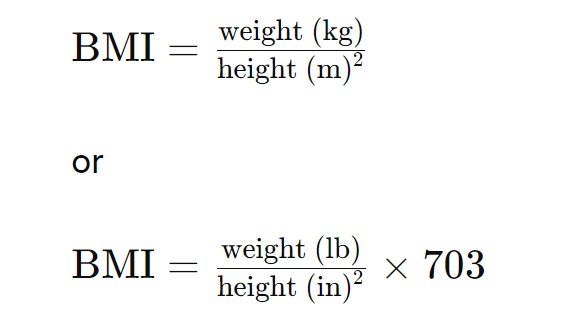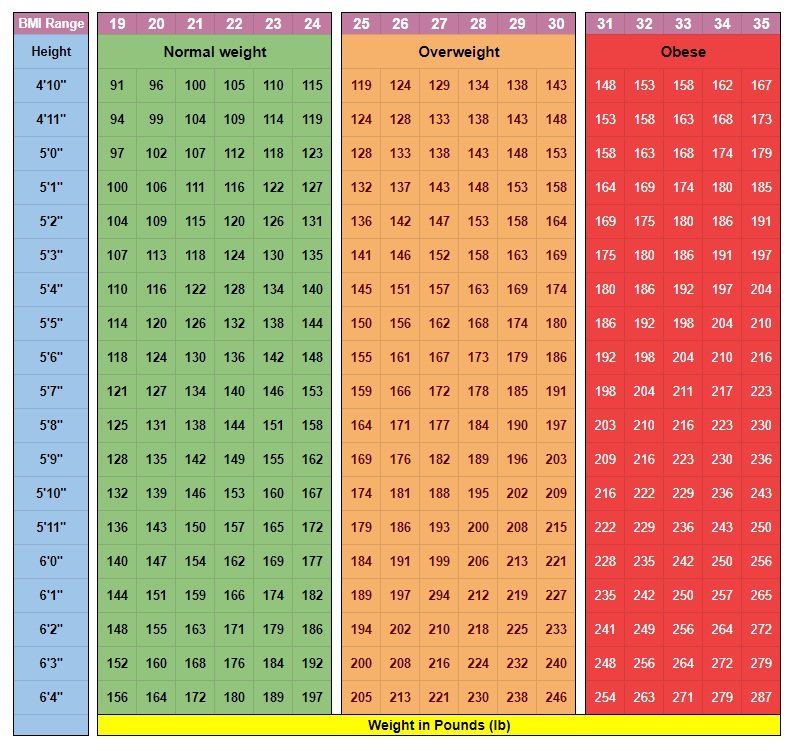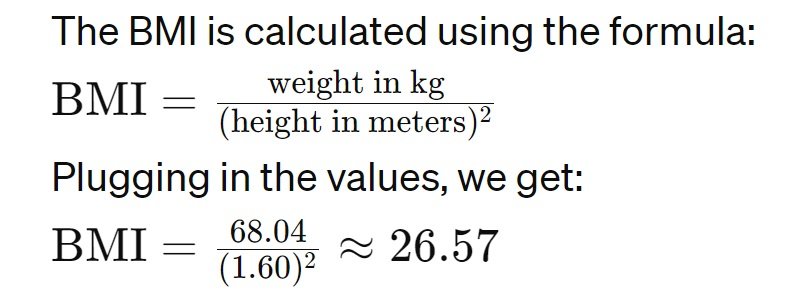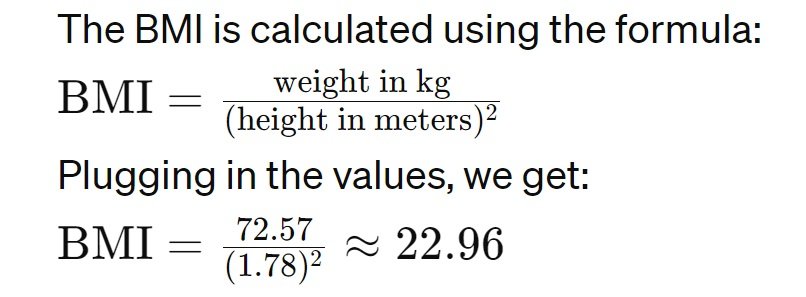Body Mass Index Calculator
BMI Ranges
Body Mass Index (BMI) is a measure of body fat based on height and weight. While it’s a useful screening tool, it doesn’t directly measure body fat and doesn’t account for factors like muscle mass, bone density, and overall body composition. Here are the BMI ranges commonly used to classify individuals:
- Underweight: BMI less than 18.5
- Normal weight: BMI between 18.5 and 24.9
- Overweight: BMI between 25 and 29.9
- Obesity:
- Class 1: BMI between 30 and 34.9
- Class 2: BMI between 35 and 39.9
- Class 3: BMI 40 or greater
Average BMI in US
BMI Formula
The Body Mass Index (BMI) is calculated using the following formula:

Where:
- Weight is measured in kilograms (kg) or pounds (lb).
- Height is measured in meters (m) or inches (in).
To use the formula:
- Convert weight to kilograms if it’s in pounds (1 kg = 2.20462 lb).
- Convert height to meters if it’s in inches (1 m = 39.3701 in).
- Square the height in meters or inches.
- Divide the weight in kilograms or pounds by the squared height to get the BMI.
BMI is commonly used as a screening tool to categorize individuals into different weight status categories, such as underweight, normal weight, overweight, and obesity. However, it’s important to note that BMI doesn’t directly measure body fat percentage and may not accurately assess health risks in all individuals, especially those with high muscle mass or specific health conditions.
BMI for Women vs BMI for Men
While the formula for calculating BMI remains the same for both men and women, there are some differences in how BMI is interpreted and applied due to variations in body composition and distribution of fat between genders.
Body Composition: Women generally have a higher percentage of body fat compared to men of the same BMI. This means that women may fall into higher BMI categories at lower levels of body fat compared to men.
Muscle Mass: Men tend to have greater muscle mass than women on average. Because muscle weighs more than fat, men with higher muscle mass may have higher BMIs compared to women with similar body fat percentages.
Health Risks: While the BMI categories are the same for men and women, the associated health risks may vary slightly between genders. For example, women with a BMI in the overweight or obesity range may have different risks for conditions such as heart disease, diabetes, and certain cancers compared to men with similar BMIs.
BMI Chart (Body Mass Index Chart)

BMI Chart for Women
BMI chart for women is generally the same for men. For adults including men and women BMI chart (Body Mass Index) provides a quick reference for assessing one’s weight status based on height and weight.
Ranging from 4’10” to 6’4″ and 91 lbs to 287 lbs, it offers a comprehensive overview. BMI is calculated using weight (in pounds) divided by the square of height (in inches) multiplied by 703.
The chart categorizes BMI into underweight, normal weight, overweight, and obese, with subcategories for different levels of obesity. It serves as a valuable tool for individuals and healthcare professionals to gauge health risks associated with weight and guide discussions on lifestyle and medical interventions.
BMI History
The history of BMI (Body Mass Index) dates back to the early 19th century when Adolphe Quetelet, a Belgian mathematician, statistician, and sociologist, introduced the concept. In the 1830s, Quetelet developed the Quetelet Index, which later became known as the BMI.
He proposed using a person’s weight divided by the square of their height as a means to assess body composition and obesity levels.
BMI gained widespread recognition in the mid-20th century as a simple and practical measure of body fatness. Since then, it has become a standard tool in medical and public health fields for evaluating weight-related health risks.
BMI Alternative
While BMI is a widely used measure, there are alternative methods for assessing body composition and health risks:
Waist-to-Hip Ratio (WHR): This ratio compares the circumference of the waist to that of the hips. Higher WHR values indicate more abdominal fat, which is associated with increased health risks.
Waist-to-Height Ratio (WHtR): Similar to WHR, WHtR compares waist circumference to height. A WHtR of over 0.5 is often considered indicative of increased health risks.
Body Fat Percentage: This method directly measures the proportion of fat in the body. It can be assessed using various techniques such as bioelectrical impedance analysis, dual-energy X-ray absorptiometry (DEXA), or skinfold calipers.
Waist Circumference: This measures the circumference of the waist and is an indicator of abdominal obesity. Elevated waist circumference is associated with higher risks of metabolic disorders and cardiovascular diseases.
Body Composition Analysis: This includes methods like DEXA scans or underwater weighing, which provide detailed insights into the distribution of fat, muscle, and bone mass in the body.
Questions and Answers on BMI Calculations
Question 1: When using a BMI calculator, which two primary measurements are needed to determine your Body Mass Index (BMI), and why might this method be considered less accurate for assessing the health status of athletes or individuals with high muscle mass?
Answer: To calculate your Body Mass Index (BMI), you need to provide your weight and height. These measurements are used to calculate BMI by dividing your weight in kilograms by the square of your height in meters. This formula gives a number that categorizes you as underweight, normal weight, overweight, or obese.
However, the BMI calculator might not accurately reflect the health status of athletes or individuals with high muscle mass. This is because muscle weighs more than fat, and BMI does not distinguish between muscle and fat mass. Consequently, a muscular person might have a high BMI but a low body fat percentage, misleadingly categorizing them as overweight or obese based on their BMI alone.
Question 2: Calculate the BMI for a woman weighing 150 pounds and standing 5 feet 3 inches tall. What BMI category does this result fall into.?
Answer: To calculate the BMI for a woman weighing 150 pounds and standing 5 feet 3 inches tall, we first convert the weight from pounds to kilograms and the height from feet and inches to meters. The conversion formulas are as follows:
- Weight: 150 pounds is approximately 68.04 kilograms (1 pound = 0.453592 kilograms).
- Height: 5 feet 3 inches is approximately 1.60 meters (1 foot = 0.3048 meters and 1 inch = 0.0254 meters).

This BMI places her in the “Overweight” category according to the standard BMI categories:
- Underweight: BMI < 18.5
- Normal weight: 18.5 ≤ BMI < 25
- Overweight: 25 ≤ BMI < 30
- Obese: BMI ≥ 30
Question 3: Calculate the BMI for a man weighing 160 pounds who is 5 feet 10 inches tall. After determining his BMI, identify which category he falls into according to the BMI scale.?
Answer:
To calculate the BMI for a man weighing 160 pounds and standing 5 feet 10 inches tall, we first convert the weight from pounds to kilograms and the height from feet and inches to meters. The conversion formulas are as follows:
- Weight: 160 pounds is approximately 72.57 kilograms (1 pound = 0.453592 kilograms).
- Height: 5 feet 10 inches is approximately 1.78 meters (1 foot = 0.3048 meters and 1 inch = 0.0254 meters).

This BMI places him in the “Normal weight” category according to the standard BMI categories:
What are the limitations of BMI Calculator?
BMI (Body Mass Index) is a widely used measure to classify weight status in adults, but it comes with several limitations that can impact its accuracy and usefulness in assessing individual health:
Does Not Distinguish Body Composition: BMI calculates weight relative to height without distinguishing between sources of weight like muscle, bone, fat, and water. This can lead to misleading classifications, particularly for athletes and bodybuilders who may have high muscle mass and low body fat but a high BMI.
Not a Direct Measure of Body Fat: BMI does not measure body fat directly. Therefore, it cannot accurately assess body fat percentage or indicate the distribution of body fat, which are important factors in evaluating health risks.
Does Not Account for Age, Sex, or Ethnicity: BMI ranges are standardized for adult men and women but do not adjust for age, which can affect body composition. Furthermore, BMI does not consider variations in body composition across different ethnic groups, which can lead to underestimations or overestimations of health risks in certain populations.
May Not Reflect Health Risks Accurately: While a high or low BMI is associated with increased health risks, it does not necessarily correlate with individual health markers such as cholesterol levels, blood pressure, and other metabolic health indicators.
Does Not Consider Fat Distribution: BMI overlooks the distribution of body fat, particularly the distinction between peripheral and central fat accumulation. Central fat (visceral fat) is a significant risk factor for cardiovascular diseases and diabetes, but BMI alone cannot identify this risk.
May Misclassify the Elderly: Older adults often experience muscle loss with age, which could lead to a normal BMI despite increased body fat percentage. This can mask obesity-related health risks in this population.
One-Size-Fits-All Approach: BMI uses the same criteria for all, without acknowledging the varying physical conditions and health profiles of individuals. This generalization can lead to inaccurate health advice or interventions based on BMI alone.
Due to these limitations, it is recommended that BMI be used in conjunction with other assessments such as waist circumference, skinfold measurements, and more direct measures of body composition like DEXA scans or bioelectrical impedance to provide a more comprehensive evaluation of an individual’s health.
Popular Tags: bmi calculator women, bmi calculator men, bmi calculator female, bmi calculator by age, bmi chart. bmi calculator teenager, bmi calculator by age and gender, bmi calculator adults, bmi calculator online, bmi alternative.